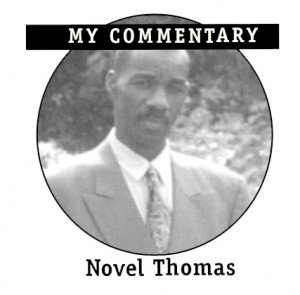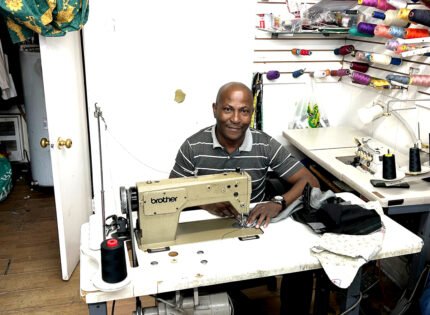I’m not one to wrap myself in national political colours, or pretend to be a pseudo historian of any kind, but as a living soul it’s incumbent on me to suck up as much as I can about where I live, as well as the rest of the world.
So listening to CBC Radio’s Cross Country Checkup last Sunday it was interesting to listen to Canadians of various backgrounds—racially, culturally, ethnically and otherwise, all of whom are (the products of) immigrants, some recent, others going back two, three, four… generations. Ultimately, we are all (the children, grandchildren, great… grandchildren of immigrants.
The only ones who are not are the obvious.
Which is why I’m almost put off by people of European background when they tell people who are visibly not European to “Get out of my country… Go back to where you came from…”
You know the talk… I myself was once told by one of Montreal’s finest to “go back to Jamaica.” That was sometime in the late 80s during my [Black male] rite of passage. Maybe if he were a descendant of those who welcomed (in retrospect, probably regrettably) I would’ve taken his advice. I’m still thinking of going to Jamaica.
So as Canada celebrates its 150th birthday this weekend, people are in party mode, some to a greater or lesser degree.
I learned of Canada’s history of colonialism — upon reflection, a sterilized version. No mention of the atrocities, indignities and inhumanities… perpetrated against the friendly, welcoming hosts… multiple generations ago. But with time historical truths invariably bubble to the surface. The true story of that unflattering period of the nation’s founding—at least from a European perspective—is unfolding… The real history of Canada, along with other perspectives, is coming to the fore in increments.
I never learned in my [old] high school history book (I believe I still have a black and blue hard cover copy in a box somewhere, guess I saved it for posterity) about Canada’s history of exclusion, further manifestations of the country’s history of racism and ethnocentrism, about Jews and Indians of Asian origin being refused entry into Canada.
An early example of what a former prime minister of Canada said a few years ago, something about certain people not being (perceived as) “Old Stock Canadians.”
I cannot recall if it is my Canadian history book that I learned of the colonizers/usurpers immigration policies vis-à-vis Black people in America wanting to escape racism by seeking a haven in Canada. But they too were not offered any welcome mat. In fact they were discouraged.
An article, “Deemed Unsuitable: Black Pioneers in Western Canada,” illustrates Canada’s racist historic immigration policy vis-à-vis Black people. It states in part, “For a period of one year from and after the date hereof the landing in Canada shall be [sic] and the same is prohibited of any immigrants belonging to the Negro race, which race is deemed unsuitable to the climate and requirements of Canada…”
This was the government of Canada’s position, under the leadership of one Sir Wilfrid Laurier, Prime Minister of Canada in 1911.” At the time, the preferred immigrants were “people from Great Britain and northern Europe… with other Europeans somewhat lower on the list, and Asians of all nationalities lower still… Black Americans were deemed “unsuitable as settlers…”
Here’s something else, The Edmonton Board of Trade in 1910 stated, “We want settlers that will assimilate with the Canadian people and in the Negro we have a settler that will never do that. Canadian immigration authorities agreed. Attempts were made to keep Blacks from obtaining immigration literature, and plans were made to use medical inspections and other deterrents to keep Blacks from entering Canada.”
As one journalist writes, “The history of Canada’s immigration policy has been one of exclusion. Today, the country continues to welcome some, but not others…”
At 150 years young, more and more of Canada’s history is still being revealed, and re-written, not just by Canada’s First Nations peoples, who have no qualms about telling of the atrocities perpetrated by colonizers.
Other immigrants of non-European persuasion are helping to tell their Canadian stories. And all, without fanfare, are having an impact on 21st century Canada.
Queens University Professor Naomi Alboim states, “The kind of people Canada needs are not just those who can fill a job now, but who can “adapt and develop to fill different jobs as they evolve and, most important, will stay in the country and have children and grandchildren and contribute…”
Like all other immigrants from everywhere, generations of Black Canadians have been doing just that.
This belies the racist arguments of the 1900s (probably prior, and into this century) that “Black people couldn’t survive in Canada’s cold climate…”
There’s ample evidence to refute all those racist and ethnocentric arguments.
Immigration historian Harold Troper, who has chronicled the nation’s dubious immigration practices in his book, None is Too Many: Canada and the Jews of Europe, addresses an aspect of the nation’s immigration policy vis-à-vis Jewish immigrants beginning in the 1920s and into the 1940s.
That period of exclusion also included Chinese and Asian [Indian] immigrants.
“150 years after Confederation, Canada is known around the world for its social diversity and its commitment to principles of multiculturalism. But the road to contemporary Canada is a winding one, a story of division and conflict as well as union and accommodation.”
So stated CBC’s Michael Enright in his June 25th Sunday morning intro.
True. But the story of its First Nations Peoples’ must be concluded before Canada is seen as the “Best country in which to live.”
As Canada continues to come to terms with its 150 years of benevolent colonialism, and its ongoing efforts to right the wrongs perpetrated against First Nations peoples, someone, borrowing a term from Australia’s Aboriginal peoples—they know the historical synonymy of both nations history of colonialism—stated in a radio discussion that Canada’s initiatives so far are all about “gesture politics.”
I get it. I too am a living product/remnant (albeit a 21st century breed) of centuries-old European colonization, demonization, dehumanization, exploitation, even cultural appropriation of my ancestral being and history. The process of what I refer to as “racio-cultural” re-appropriation has been a long and arduous one, but it continues…
Given the 150th celebration context, gestures are misplaced, indeed out of the question. In the greater historical scheme of things, it will take more than gestures on the part of government(s) and other institutions to address and rectify 150 years of First Nations’ [Peoples’] grievances.
In this continuing period of national celebration, everything sounds well meaning… theoretically; it’s a national love fest, but practically without substance.
Not all First Nations people are celebrating; many say they have no reason, or nothing, to celebrate.
When all is said and done, most people living in this country would agree, and say without equivocation, some even grudgingly, “Canada is a wonderful place to live.”
As a dear colleague of mine likes to refer to it in conversation and verse: “My home and chosen land.”













